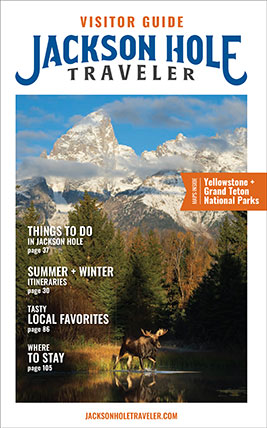Welcome Pardner!
Jackson Hole is where the untamed spirit of the West lives on, jagged mountain spires reach to the sky above an unparalleled landscape, and the crystal waters of the mighty Snake River run through it all. This is the scenery that spurred our nation to establish the world’s first national park, Yellowstone National Park, in 1872, and its equally spectacular neighbor to the south, Grand Teton National Park, in 1929. These parks are part of the Greater Yellowstone Ecosystem, one of the largest, nearly intact temperate-zone ecosystems remaining on earth.
Even knowing about Grand Teton and Yellowstone, most visitors are surprised to learn how much there is to see and do in this magnificent valley. The variety of activities and events is so extensive you’ll probably wish you had more time to spend here. This website will help you pack in as much fun and adventure as possible.
Rugged Adventurers, Stoic Settlers
The name Jackson Hole refers to an entire valley in the northwest corner of Wyoming, surrounded by mountains. Originally named after an 1820s fur trapper, Davey Jackson, it’s 48 miles long and between 8 and 15 miles wide. The northern end of the valley serves as the southern gateway to Yellowstone National Park and is about 6,779 feet above sea level. The town of Jackson (whose name is often confused with the valley, Jackson Hole) sits at the southern end of the valley, at an elevation of about 6,069 feet.
Although Native Americans passed through this valley thousands of years ago, the long, harsh winters discouraged any permanent settlement until the late 1800s. After the town of Jackson was established in 1894, homesteaders began to trickle in, lured by the prospect of open land for the taking. They faced a hard existence and eked out a living through a combination of cattle ranching, farming and big-game hunting. Descendants of some of those early settlers still ranch or reside within the valley today.
In 1920, Jackson residents elected an all-female town council, continuing the pioneer spirit of Wyoming that earned it the nickname of Equality State when it became the first state in the country to grant women the right to vote in 1869.
Yellowstone and Grand Teton national parks have always drawn sightseers to this region, but Jackson Hole’s tourist trade truly took root in the 1920s, when dude ranches like the still-operating Triangle X Ranch began inviting visitors to stay. A “dude,” in Western parlance, is a guest who pays to experience cowboy ranch life.
Perhaps nothing shaped the identity of Jackson Hole from a cowboy town to a ski town as much as the creation of the Jackson Hole Mountain Resort in 1965. Indeed, the acclaimed ski resort was built at the site of a dude ranch called Crystal Springs Ranch. Nearly overnight, the resort helped propel the valley from a one-season economy to a year-round one, drawing visitors from every corner of the world.
Jackson Hole Today
With a population that has now expanded to about 23,000 residents, Jackson Hole is not the isolated valley it once was. Even so, locals are easily outnumbered by some 4 million visitors each year. In addition to being the home of Grand Teton and Yellowstone national parks, two major ski areas (and a third just “over the hill”), the National Elk Refuge and Bridger-Teton National Forest, we also have a thriving cultural scene. From world-class art to live theatrical, musical and dance performances— featuring national and international actors, musicians and dance companies—Jackson Hole is far from a sleepy valley.
A nod to the past is carefully maintained with the decidedly Western air evident most everywhere, including wooden boardwalks around Town Square, twice-weekly rodeo, the Jackson Hole Shootout and authentic chuck wagon dinners. There are plenty of experiences to bring out the inner cowboy in everyone.
Fun Fact: Jackson Hole was recently named one of the friendliest cities in the country by USA Today, and one of the friendliest in the world by Conde Nast Traveler!
A Myriad of Adventures in Store for You
“I came for the winter, but stayed for the summer,” is a popular saying by locals who have long understood the lure and beauty of Jackson Hole during the all- too-short summer months. It’s a postcard come to life, framed by the magnificent Teton Range. Thanks to efforts of generations of conservationists, 97% of this beautiful landscape is public land and protected from development. For outdoor enthusiasts, Jackson Hole has a role as both a sanctuary and a playground, no matter what the season. There are hundreds of trails to tackle, many mountains to climb and ski down, abundant wildlife to spot, rivers and lakes to float and fish on, and so much more.
So welcome—and let the memories begin!



